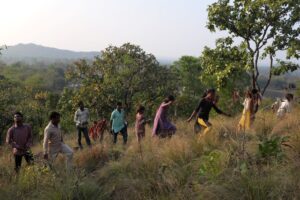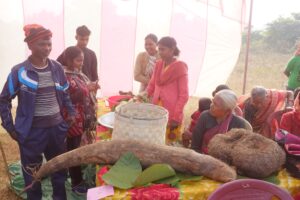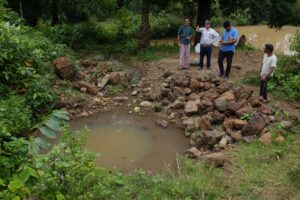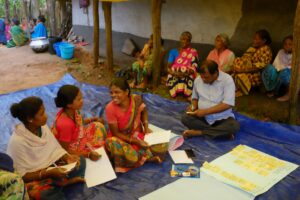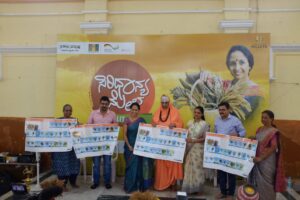As part of the Using Diversity (UD) Network Project, Keystone in collaboration with other UD partners is working with 11 Pahari Korwa villages in Raigarh District of Chhattisgarh. The Pahari Korwas are one of Chhattisgarh’s 5 tribal groups notified as PVTG. The UD project activities in Raigarh district are being carried out by community fellow Bhawaru Ram Hansda and Jaykumar Yadav who are currently based out of Ganeshpur village in Dharamjaigad block. In the second week of March, 2018 I made a field visit to Raigarh district where accompanied by Bhawaru and Jaykumar I visited Ganeshpur, the hamlets of Chui Pahar and Barghat village.
Ganeshpur
In Ganeshpur I got the opportunity to explore the practice of Bewra a traditional form of shifting cultivation through which the Pahari Korwas cultivate a variety of millets, pulses, rice and maize crops. We visited the Bewra fields where Somari Bai was hard at work collecting firewood from amongst the trees and shrubs which had been recently felled to prepare the area for Bewra. Somari Bai is a widow residing in Ganeshpur and the survival of her small family depends largely on Bewra. She informed us that in February and March trees and plants are felled to prepare a plot for Bewra, with the men carrying out the felling and the women collecting the small trees and branches for firewood. A majority of the felled trees and shrubs are then left to dry till the end of May when they are burnt in preparation for sowing in June. Just before the onset of the monsoons they sow a variety of seeds like Jhunga, Bede, Rahar, Sutru, Kang, Madia, Sokda, Mati Urad, Bajra, Lal Amari, Tuma and Lai Bhaji. The seeds are sown prior to the first rains in order to prevent the ash from burning of trees and shrubs from being washed away, which in turn ensures healthy growth of the crops once the rains commence. The crops start ripening in September and harvesting is carried out from September to November. After cultivation the land is left fallow for one or two years, though the plot Somari Bai was working on was an exception according to Bhawaru, as it had been left fallow for over 5 years.
Somari Bai pointed out that the practice of Bewra is currently under serious threat largely due to increased conflict with the Forest Department. Forest officials harass them when they carry out Bewra and tell them that felling of trees for Bewra is prohibited. While a few households of Ganeshpur have received small Individual Forest Rights titles under FRA these do not include traditional Bewra lands which fall under forest areas. The village Patel also pointed out that a CFR claim had been submitted but unfortunately the receipt has been misplaced which is making it hard for them to follow up on the claim.
 Bhawaru and Jaykumar are working with the villagers of Ganeshpur and other project villages to understand the status of land tenure through the implementation of Forest Rights Act especially with regards to Community Forest Rights (CFR) which provides forest dwelling communities the legal rights to access the forest land they have depended upon for several generations as long as the forests are being used sustainable for their livelihood needs. In this regard they will spread awareness and support the villagers with regards to the due processes involved in submitting and following up on IFR, CFR and Habitat Rights claims. They are also focussing on the safeguarding and revival of Bewra. A community seed bank has been established in Ganeshpur which will help revive traditional bewra crops whose seeds are hard to come by or have disappeared completely from certain areas. Bhawaru and Jaykumar have already helped procure seeds of 16 crops from various Pahari Korwa, Baiga and Bhariya villages in Chhattisgarh and Madhya Pradesh. The community seed bank will supply seeds to farmers across the 11 project villages and the farmers in turn will return a larger amount of seeds to the seed bank after harvesting the crops, with the amount to be returned being jointly determined by the villagers and farmers. This would enable the expansion of the seed bank which will allow it to cater to more and more farmers in subsequent years.
Bhawaru and Jaykumar are working with the villagers of Ganeshpur and other project villages to understand the status of land tenure through the implementation of Forest Rights Act especially with regards to Community Forest Rights (CFR) which provides forest dwelling communities the legal rights to access the forest land they have depended upon for several generations as long as the forests are being used sustainable for their livelihood needs. In this regard they will spread awareness and support the villagers with regards to the due processes involved in submitting and following up on IFR, CFR and Habitat Rights claims. They are also focussing on the safeguarding and revival of Bewra. A community seed bank has been established in Ganeshpur which will help revive traditional bewra crops whose seeds are hard to come by or have disappeared completely from certain areas. Bhawaru and Jaykumar have already helped procure seeds of 16 crops from various Pahari Korwa, Baiga and Bhariya villages in Chhattisgarh and Madhya Pradesh. The community seed bank will supply seeds to farmers across the 11 project villages and the farmers in turn will return a larger amount of seeds to the seed bank after harvesting the crops, with the amount to be returned being jointly determined by the villagers and farmers. This would enable the expansion of the seed bank which will allow it to cater to more and more farmers in subsequent years.
Chui Pahar
 Chui Pahar a hill under Krida Panchayat is home to 6 hamlets. Currently Churchu Pahar is only accessible by foot through a steep rocky trail, while the villagers are striving to construct a motorable road which can currently only be used by tractors and four wheelers. The six hamlets of Chui Pahar are home to villagers of the Pahari Korwa (PVTG), Uraon (ST) and Yadav (OBC) communities. While Bewra is still practiced in Chui Pahar, there has been an expansion of permanent forms of cultivation which involves both mixed cropping and monocultures mostly of rice. In addition villagers also cultivated Ganja which was grown extensively in the past but is reducing significantly due to a shift in demand away from their more wild variety to the Ganga from Odisha. Interactions with villagers revealed that before the arrival of the Uraons and Yadavs, the Pahari Korwas depended largely on Bewra and there was virtually no permanent cultivation. The Uraons and Yadavs commenced permanent cultivation mostly of rice which was also slowly picked up by the Pahari Korwas. However, the Pahari Korwas still largely depend on Bewra and collection of forest produce as a result of which the majority of land in the area is largely controlled by Yadavs and Uraons.
Chui Pahar a hill under Krida Panchayat is home to 6 hamlets. Currently Churchu Pahar is only accessible by foot through a steep rocky trail, while the villagers are striving to construct a motorable road which can currently only be used by tractors and four wheelers. The six hamlets of Chui Pahar are home to villagers of the Pahari Korwa (PVTG), Uraon (ST) and Yadav (OBC) communities. While Bewra is still practiced in Chui Pahar, there has been an expansion of permanent forms of cultivation which involves both mixed cropping and monocultures mostly of rice. In addition villagers also cultivated Ganja which was grown extensively in the past but is reducing significantly due to a shift in demand away from their more wild variety to the Ganga from Odisha. Interactions with villagers revealed that before the arrival of the Uraons and Yadavs, the Pahari Korwas depended largely on Bewra and there was virtually no permanent cultivation. The Uraons and Yadavs commenced permanent cultivation mostly of rice which was also slowly picked up by the Pahari Korwas. However, the Pahari Korwas still largely depend on Bewra and collection of forest produce as a result of which the majority of land in the area is largely controlled by Yadavs and Uraons.
While hamlets of Chui Pahar are gradually receiving Government infrastructure and access to various schemes and programs, progress is slow. While the hamlets had government schools and teachers, the schools were operating out of the School Kitchen as only the kitchens had been constructed and the main school building was yet to be built. The teachers move from hamlet to hamlet but conduct virtually no classes. The parents complained that other than MDM the schools offered no education to their children. On a more positive note Chui Pahar hamlet had a recently built Angan Wadi centre and most village households had been provide solar lighting. Also Pradhan Mantri Awas Yojna is being implemented extensively across Chui pahar and while initially villagers had to purchase bricks from villages below Chui Pahar at exorbitant rates they are now making their own bricks.
The mud of Chui Pahar is very valuable for construction purposes and the one of the major sources of livelihood for the villagers is the sale of Chui Matti. They also sell Dhup from the Sarai tree, and carry out cultivation of a variety of crops to meet subsistence needs and also to sell in the market. Forest produce also makes a vital contribution towards the livelihoods of the villagers of Chui Pahar, who collect a variety of wild vegetables, tubers, fruits and seeds for self consumption and also sell some produce like mahua and char. The villagers also hunt and wild meat supplements their diet.
With regards to FRA there is very little awareness among villagers of all the hamlets especially with regards to the formation and role of FRCs, CFR and Habitat Rights. While a few households have received IFR titles there is little transparency or understanding of the process of allocation of titles. In fact in Sirdahi hamlet where we spent the night none of the 14 households have received IFR titles despite submission of forms. With regards to CFR claims there is no understanding of the process of submitting CFR claims and none of the hamlets have submitted CFR claims.
 We spent the night in Sirdahi hamlet which is home to 14 Pahari Korwa households and 32 households of the Uraon and Yadav communities. We stayed with an elderly Pahari Korwa couple, Siaram and Somru bai. On the 13th we accompanied villagers for wild food collection from the neighbouring forest areas. The group of villagers we accompanied comprised of 4 Pahai Korwas and 3 Uraon men. Just after leaving the hamlet the men came across a bee hive in a rock crevice and extracted honey combs from it. As the hive was relatively new the combs were white with little honey in them. The men informed us that the season was only just commencing and in a few weeks the combs would be full of honey. Despite the lack of honey the combs made for a chewy treat. The bees whose hive was harvested were locally known as mohni madumakhi and were most likely Apis cerana. Making their way through empty field the men made their way into the forest where they found and dug up a tuber locally known as Pidharu Kanda which is either boiled or roasted on a fire. The extraction of the tuber was extremely labour intensive and time consuming. Five of the men took turns to dig a pit around 3-4 feet in depth, 3 feet in length and 2 feet in width. They used pick axes, spades and a spear like tool called Kunthi to dig the pit and extract the tubors.
We spent the night in Sirdahi hamlet which is home to 14 Pahari Korwa households and 32 households of the Uraon and Yadav communities. We stayed with an elderly Pahari Korwa couple, Siaram and Somru bai. On the 13th we accompanied villagers for wild food collection from the neighbouring forest areas. The group of villagers we accompanied comprised of 4 Pahai Korwas and 3 Uraon men. Just after leaving the hamlet the men came across a bee hive in a rock crevice and extracted honey combs from it. As the hive was relatively new the combs were white with little honey in them. The men informed us that the season was only just commencing and in a few weeks the combs would be full of honey. Despite the lack of honey the combs made for a chewy treat. The bees whose hive was harvested were locally known as mohni madumakhi and were most likely Apis cerana. Making their way through empty field the men made their way into the forest where they found and dug up a tuber locally known as Pidharu Kanda which is either boiled or roasted on a fire. The extraction of the tuber was extremely labour intensive and time consuming. Five of the men took turns to dig a pit around 3-4 feet in depth, 3 feet in length and 2 feet in width. They used pick axes, spades and a spear like tool called Kunthi to dig the pit and extract the tubors.

The men pointed out that the effort required to extract the tubers varies based on the depth of the tubor. While the tuber extraction I witnessed required considerable digging, another extraction was less labour intensive as the tuber was closer to the surface. In addition to the tubers the villagers also collected Sahar, which are large seed pods. We then made our way to a natural water source close to the village where a bonfire was prepared to roast the Sahar. The villagers pealed open the charred Sahar pods to extract the seeds, which were pealed to reveal a tender flesh which was then consumed. The villagers divided the seeds among themselves equally, and Bhawaru took a number of them for his nieces and nephews in Barghat village where we were headed next, along  with a few unopened pods to use as samples in his community seed bank. We then made our way down to Kridha where we had left our bike via Chui Tola. In Chui Tola we spent some time in Birha’s house who unfortunately was sick at the time. We discussed distribution of seeds of traditional crops that have reduced or disappeared from Chui pahar to farmers of the area. It was decided that the seeds would be distributed directly to the farmers in 2018 and subsequently a small community seed bank would be established in Birha’s house in 2019 where the farmers would deposit seeds and new seeds would also be added.
with a few unopened pods to use as samples in his community seed bank. We then made our way down to Kridha where we had left our bike via Chui Tola. In Chui Tola we spent some time in Birha’s house who unfortunately was sick at the time. We discussed distribution of seeds of traditional crops that have reduced or disappeared from Chui pahar to farmers of the area. It was decided that the seeds would be distributed directly to the farmers in 2018 and subsequently a small community seed bank would be established in Birha’s house in 2019 where the farmers would deposit seeds and new seeds would also be added.
Barghat village
 After making our way down to Kridha we travelled to Barghat village via Kumarta, Tilsa Pahar, Seksari and Sarguja. Barghat under Kurmarta Panchayat comprises of 35 households. This village has faced the brunt of man animal conflict in recent years with the village houses being destroyed by elephants three times in the last 3 years. The villagers reported that elephants visited the village prior to 2016 as well but never damaged any houses or buildings but once they first destroyed houses mainly to access food grain, it become a regular occurrence. In May 2016 elephants destroyed all 35 houses, the school and the Angan Wadi centre. In fact, an entire concrete wall of the Angan Wadi centre was completely broken by the elephants in order to access the grains and food supplies stored within. The devastation did not end there with the elephants returning to destroy 15 houses in August 2017 and as recently as February 2018 to destroy 12 houses. While this constant devastation forced the villagers to abandon their village they returned after a year and are now in the process of rebuilding their precarious lives. A number of households have succeeded in availing the benefits of the Pradhan Mantri Awas Yojna and are constructing concrete house with support from the scheme. Other families continue to live in partially broken mud houses while steadily repairing them. The village on the whole is perpetually on the alert of future attacks with
After making our way down to Kridha we travelled to Barghat village via Kumarta, Tilsa Pahar, Seksari and Sarguja. Barghat under Kurmarta Panchayat comprises of 35 households. This village has faced the brunt of man animal conflict in recent years with the village houses being destroyed by elephants three times in the last 3 years. The villagers reported that elephants visited the village prior to 2016 as well but never damaged any houses or buildings but once they first destroyed houses mainly to access food grain, it become a regular occurrence. In May 2016 elephants destroyed all 35 houses, the school and the Angan Wadi centre. In fact, an entire concrete wall of the Angan Wadi centre was completely broken by the elephants in order to access the grains and food supplies stored within. The devastation did not end there with the elephants returning to destroy 15 houses in August 2017 and as recently as February 2018 to destroy 12 houses. While this constant devastation forced the villagers to abandon their village they returned after a year and are now in the process of rebuilding their precarious lives. A number of households have succeeded in availing the benefits of the Pradhan Mantri Awas Yojna and are constructing concrete house with support from the scheme. Other families continue to live in partially broken mud houses while steadily repairing them. The village on the whole is perpetually on the alert of future attacks with  5 villagers patrolling the village and surrounding areas for elephants every night, ready to warn fellow villagers to take shelter if there is an elephant sighting. Most of the village children reside on the roof of the Government School and other government buildings under make shift tarpaulin tents. Despite the severe hardships being faced by the villagers it was heartening to watch the children preparing for bed without any complaints. When asked if they were taking any steps to prevent further attacks from elephants the villagers said that they use catapults to chase them away, targeting the ears which are the most sensitive part of their bodies, which forces the elephants to retreat.
5 villagers patrolling the village and surrounding areas for elephants every night, ready to warn fellow villagers to take shelter if there is an elephant sighting. Most of the village children reside on the roof of the Government School and other government buildings under make shift tarpaulin tents. Despite the severe hardships being faced by the villagers it was heartening to watch the children preparing for bed without any complaints. When asked if they were taking any steps to prevent further attacks from elephants the villagers said that they use catapults to chase them away, targeting the ears which are the most sensitive part of their bodies, which forces the elephants to retreat.
While the entire village had abandoned the area after the 2016 attack, they returned to cultivate their fields in 2017 and had a good harvest comprising a wide variety of crops. As a result of constant conflict with the Forest Department the villagers have reduced the practice of Bewra which is now restricted to areas of shrub and weeds close to the village. However, they still carry out traditional mixed cropping on a more permanent basis which yields a variety of crops. The main sources of livelihood for the villagers of  Barghat are agriculture, collection and sale of firewood; selling a variety of forest produce like tendu, sarai seeds, bhera fruits, harra, dhawai flowers, mangoes and char. They also collect a variety of wild vegetables, mushrooms, tubers, fruits, flowers and seeds for self consumption. Several villagers helped us list the rich variety of uncultivated food they derive from the forests and community lands. Sadly they regretted that several uncultivated foods are diminishing and the younger generations are hard pressed to identify several UF which were common when they were children.
Barghat are agriculture, collection and sale of firewood; selling a variety of forest produce like tendu, sarai seeds, bhera fruits, harra, dhawai flowers, mangoes and char. They also collect a variety of wild vegetables, mushrooms, tubers, fruits, flowers and seeds for self consumption. Several villagers helped us list the rich variety of uncultivated food they derive from the forests and community lands. Sadly they regretted that several uncultivated foods are diminishing and the younger generations are hard pressed to identify several UF which were common when they were children.
While there has been some progress with regards to the distribution of IFR titles in Barghat, there is no awareness of CFR and processes involved in submitting CFR claims. Bhawaru and Jaykumar will be distribution a variety of seeds to farmers of Barghat for cultivation mostly through traditional mixed cropping. They will also be spreading awareness on FRA with a focus on efforts to submit and follow up CFR claims.


